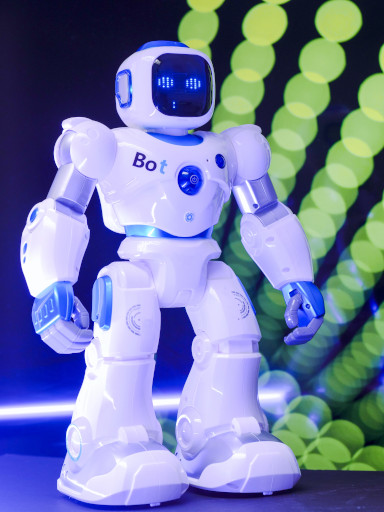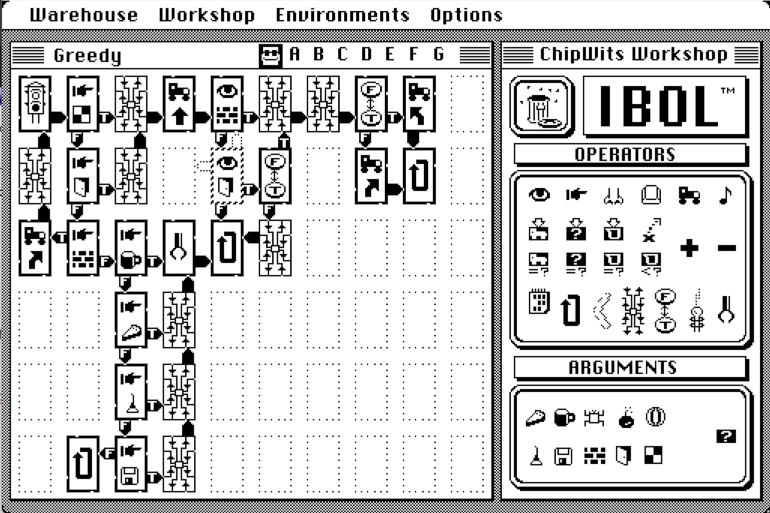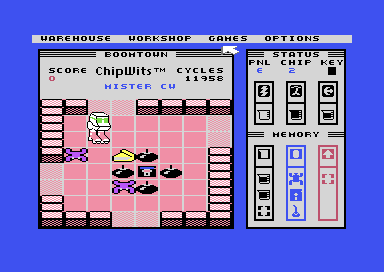Before we start walking through our development progress on the reboot of ChipWits, we’d like to introduce (or review, for those who have already played) the game design of the original version of the game.

Robots in Our Lives
When the game debuted in 1984, the manual claimed that robots were just starting to become part of our everyday lives. Today, it is not uncommon to see robots that vacuum our houses and mow our lawns. Drones can routinely be spotted taking videos from previously impossible perspectives. In industry, robots are assembling and disassembling products with high accuracy, and reducing the time it takes to package and ship items to our homes. Robots are increasing farm production in agriculture. In medicine, robots are even performing surgery!
Whether you’re young or old, and whether you are new to programming or an elite coder, ChipWits has always been about giving you an opportunity to experiment with programming robots. While doing so, you’re not only having fun but you’re exercising problem solving skills that help you in real life!
Objective
The game is presented as a simulator, with four components:
- The Warehouse – This is where your robots (ChipWits) are stored. There are fixed slots for 16 robots
- The Workshop – This is where you program your robot
- Environments – Allows you to select one of 8 environments for your ChipWit to explore
- Mission Screen – Watch your ChipWit perform its mission!
Workshop (IBOL Editor)
The centerpiece of the original game design is a visual programming language called IBOL. In the workshop, you place chips in a grid to program your ChipWit. This gives it instructions for completing its mission.

The language used to program the ChipWit is called IBOL and consists of 8 subpanels (Main, A, B, C, D, E, F, and G), each of which has a 10 x 6 grid of chip slots. To program the ChipWit, you place chips in these slots, and configure connectors to direct which chip comes next.

Each chip has an operator (in this case “IFSEE”) which specifies what the chip does. Some chips have an argument which configures the behavior of the operator. Finally, each chip optionally has one or two connectors which direct which chip comes next.
This chip is an “IFSEE” chip, which looks ahead of the ChipWit. If it sees the argument (a door, in this case), it follows the “True” connector. Otherwise, it follows the “False” connector.
On the right of the workshop is a palette of available operators and arguments. Using these simple chips, you can create sophisticated programs to complete missions.
We’ll get into IBOL in other articles, but it has several other interesting features such as stacks, recursive calls, randomness, and simple arithmetic operators, going beyond what many coding games cover, even today!
Environments
The original version of ChipWits comes with eight environments with a diversity of mission objectives:
- Greedville: Acquire as many good things as possible
- ChipWit Caves: Zap electrocrabs while grabbing good items
- Doom Rooms: Survive as long as possible
- Peace Paths: Acquire good things but don’t harm the electrocrabs or bouncers
- Memory Lanes: Move from one end of a maze to the other as many times as possible
- Octopus Garden: Retrieve one good thing at the end of each arm extending from a central room
- Mystery Matrix: Discover the optimal pathway through a matrix of rooms by deciphering signposts
- Boomtown: Collect items while avoiding touching bombs

Your objective is to create a ChipWit that achieves one or more of these objectives, maximizing your score.
Or, you can choose to create a robot that totally ignores the mission objectives and does whatever you want. It’s an open-ended simulation, so if you want to create a robot that just crashes into things, have at it!
Discussion
That’s pretty much it! The game was simple, but addictive and fun. Many players recall spending countless hours trying to figure out why their ChipWit isn’t doing what they expect and experiencing the joy of fixing a nasty bug in its program.
If you played the original ChipWits or not, what did you think of the original game design? What was intuitive or confusing to you? What features would you like to have seen?
Comment below and we’ll use your feedback to help inform the design of our new game!

Leave a Reply